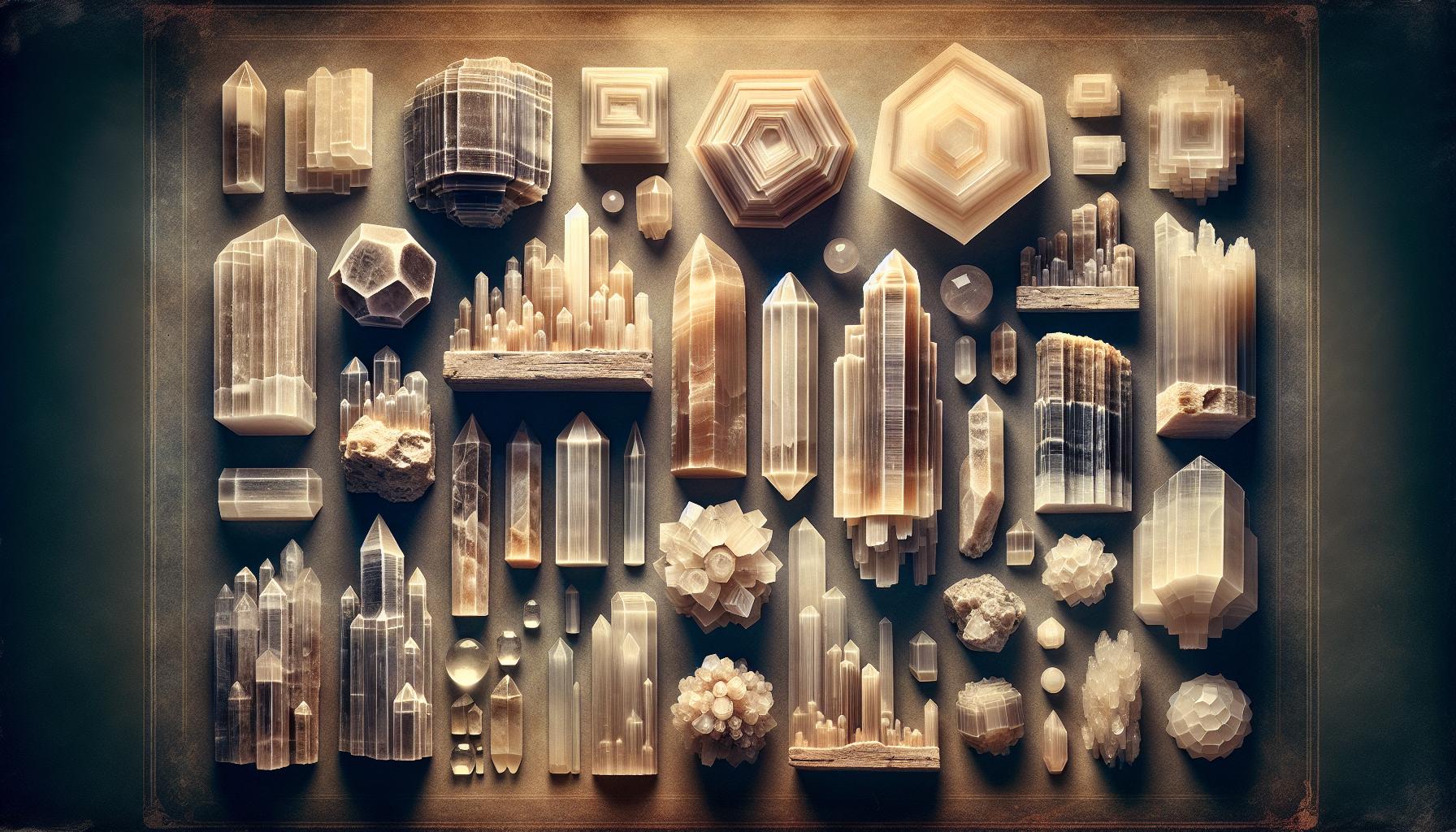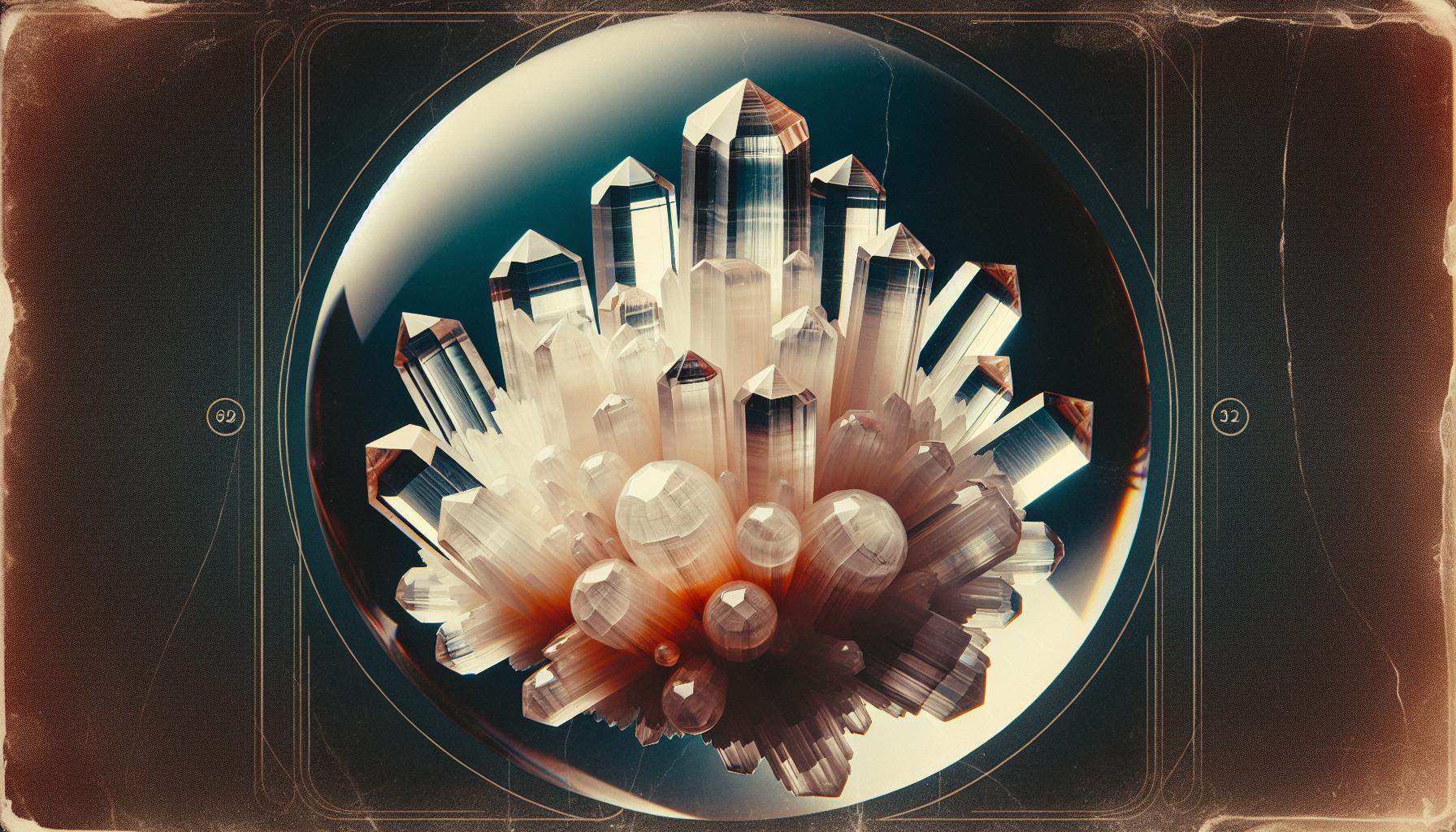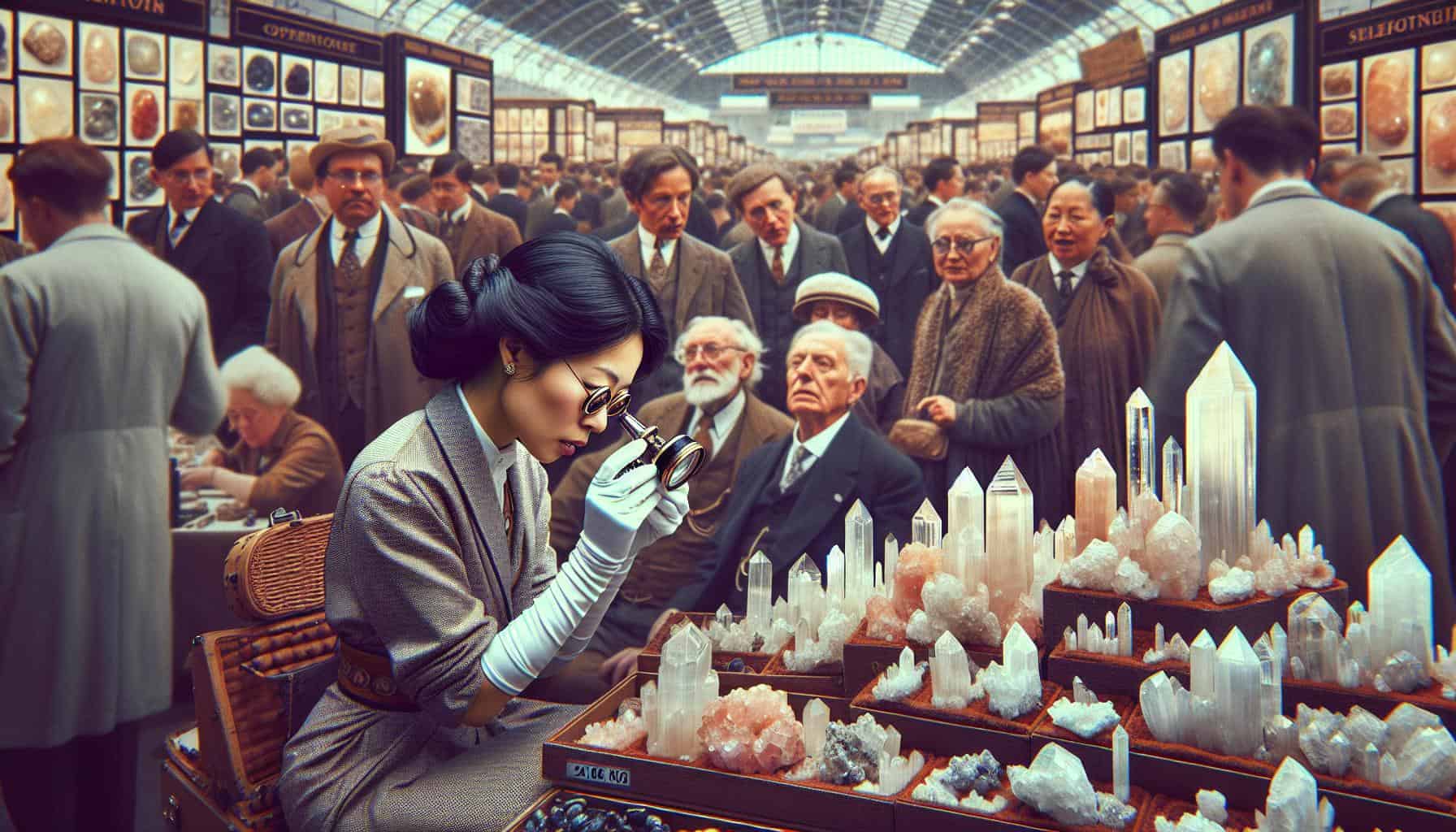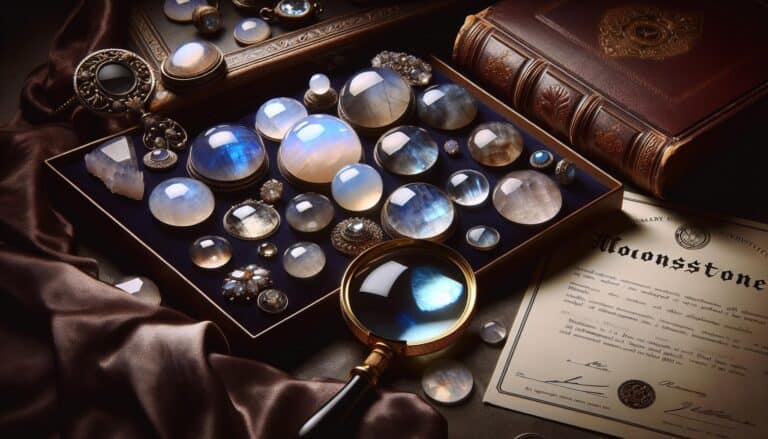You’ve probably seen selenite’s ethereal glow in crystal shops and wondered about its value.
This luminous mineral, named after the Greek goddess of the moon, Selene, isn’t just a pretty face. Selenite’s worth is determined by several factors, from clarity to size, and even the location where it’s mined.
Understanding the value of selenite means delving into its unique properties and market demand. Whether you’re a collector or just curious, knowing what affects selenite’s price can help you make informed decisions.
Let’s explore the aspects that contribute to the worth of this serene and powerful crystal.
Selenite’s value is influenced by clarity, color, and cut, with transparent forms and fewer inclusions being most prized. Origin matters too, as pieces from renowned locations like Mexico’s Cave of the Crystals command higher prices. Rarity, especially in unique colors or formations, also significantly affects selenite’s market worth.
What Is Selenite?
When you’re delving into the world of minerals and crystals, selenite pops up as a term you can’t miss. It’s a form of gypsum crystal, renowned for its pearlescent sheen and ethereal glow that’s reminiscent of moonlight. Its unique lure isn’t just visual; many believe selenite possesses healing properties and the ability to cleanse spaces from negative energy.
The mineral comes mainly in transparent and translucent forms, with white, often clear streaks. It’s a soft mineral, ranking a mere 2 on the Mohs scale of hardness, which means it’s easily scratched or damaged compared to other minerals. This characteristic is crucial when storing or handling selenite, as its delicate nature requires special care to maintain its aesthetic appeal.
Selenite’s clear quality can be so pristine that large sheets of it have historically been used as window panes in some areas, allowing light into a room with a touch of natural elegance. These large crystalline formations are found mainly in countries with significant gypsum deposits, including Mexico, Morocco, and the United States.
With an understanding of what selenite is and its unique qualities, you’re better equipped to appreciate not only its visual beauty but also its potential value in the market. Keep in mind, while it does possess a soft, subtle luminescence, handling and storing your selenite properly is crucial to preserving your investment. It’s essential to consider factors like temperature, humidity, and physical contact when managing your selenite collection, ensuring that each piece retains its lustrous charm for as long as possible.
Selenite Prices: Factors That Affect Value

When you’re in the market for selenite, you’ll discover its price can vary significantly. The value of selenite is influenced by various factors, some of which might not be immediately apparent. Understanding these factors helps you make more informed decisions when adding to your collection.
Color, Clarity, and Cut Quality
The inherent features of the crystal, such as Color, Clarity, and Cut Quality, are pivotal in determining the value of selenite. Typically, a clear, well-cut selenite with no visible inclusions is more sought after and, therefore, more valuable. Remember, though, selenite’s natural sheen can often mask minor inclusions, which can affect its overall appeal.
- Color: Pure selenite is translucent to white, but you may also find selenite tinted by impurities with hues like pink, green, or even blue. The presence of such colorations, assuming they enhance the stone’s beauty, can add to its market value.
- Clarity: The clearer the stone, the more desirable it becomes. Selenite crystals with higher transparency are generally considered more valuable than those with cloudiness or murkiness.
- Cut Quality: Selenite is not typically facet-cut due to its softness, but when it is expertly shaped or engraved, it can significantly boost its worth.
Market Demand and Availability
Like every other product, the principles of supply and demand govern selenite’s market value. Selenite’s price can fluctuate based on its current popularity and the market trends in the crystal and gemstone industry. The more sought-after a piece of selenite is, the higher its potential price tag, especially for pieces that are unique or of exceptional quality.
Selenite’s availability also plays a crucial role. Although generally considered an abundant mineral, certain forms of selenite, especially those with unique features or from specific locations, may be less common and thus more valuable. Rarity can make an otherwise average selenite crystal more attractive to collectors willing to pay a premium.
Market trends are not static, and neither is the value of selenite. It’s essential you keep an eye on market fluctuations and availability to understand how much selenite is worth at any given time. It’s not just about the current state of the market—historical prices and forecasted trends also influence value.
Always take the time to verify the credibility of your sources, whether it’s dealing with dealers or referencing prices. Inaccurate valuations can lead to overpaying or undervaluing the true worth of selenite in your collection.
Understanding Selenite: A Rare Gem

The Rarity of Selenite
When you’re evaluating gemstones, rarity often indicates greater worth, and selenite is no exception to this rule. As a variety of the mineral gypsum, selenite boasts a transparent quality that’s not commonly found in other specimens within the gypsum family. This uniqueness positions it as a rarer and often more desirable collectible.
You’ll find that selenite’s worth is directly influenced by its rarity. The lesser-spotted forms, such as bright, clear crystals or those with unique inclusions, can fetch higher prices. Selenite’s variant, satin spar, is often misidentified as true selenite, yet it’s more abundant and not as highly valued. So when you’re on the hunt for selenite, it’s crucial to recognize the real deal.
Origins and Characteristics
Selenite’s origins trace back to evaporative deposits, primarily around saline lakes and hot springs. Given the conditions required for its formation, selenite is not widespread, contributing to its rarity and value. Mexico, specifically the Cave of the Crystals, is renowned for hosting some of the largest selenite crystals ever found. However, other notable deposits exist in places such as Morocco, Greece, and the United States.
The characteristics defining selenite include:
- Luster: Selenite has a pearly luster unique to its crystalline structure.
- Transparency: Exceptional specimens offer a high level of transparency.
- Cleavage: Selenite has a very clear cleavage, which means it breaks along smooth planes.
- Durability: It’s relatively soft compared to other minerals, making it delicate and more suited for collection than daily wear.
When examining a piece of selenite, its origin may contribute to its authenticity and by extension, its value. Collectors and enthusiasts are often willing to pay a premium for specimens that boast a storied provenance or exhibit phenomenal characteristics that set them apart from more common iterations. Understanding where and how selenite forms will help you gauge the worth of the pieces in your collection and make informed decisions when acquiring new gems.
Selenite Grading and Valuation
The Grading System for Selenite
When you’re considering buying selenite, it’s crucial to understand how it’s graded. Unlike more common gemstones like diamonds, selenite doesn’t have a universally accepted grading system. However, experts often assess selenite quality based on clarity, size, luster, and whether it’s natural or enhanced in any way.
Grading criteria may include:
- Transparency: The more transparent a selenite crystal, the more valuable it can be.
- Color: Pure selenite is clear, but impurities can give it hues that either enhance or decrease its value.
- Luster: A selenite’s shine is a sign of its quality. A bright, natural luster is highly sought-after.
- Size and shape: Larger pieces and those with more desirable shapes generally fetch higher prices.
- Natural vs. Enhanced: Untreated stones are usually more valuable than those that have been dyed or altered.
Keep in mind that selenite’s softness makes it more delicate than other minerals, which can affect its long-term durability and maintenance, ultimately influencing its value.
Certification and Appraisal
For peace of mind and insurance purposes, you might seek a professional certification or appraisal of your selenite gem. A certified gemologist can provide an official document that attests to your selenite’s authenticity, quality, and value. This certification is especially important if you’re handling high-quality selenite or if you’re planning to sell or insure your piece.
Certification often involves:
- Verifying the gemstone’s authenticity.
- Documenting the selenite’s characteristics.
- Providing an estimated market value.
It’s wise to only use appraisers who are affiliated with reputable organizations such as the American Gem Society or the Gemological Institute of America. Their rigorous standards ensure that the documentation you receive is both reliable and recognized internationally.
Remember, the more transparent and documented your selenite’s quality is, the easier it’ll be to establish its worth. Whether you’re an avid collector or a casual enthusiast, knowing how to grade and value your selenite is key to ensuring that you’re making a sound investment.
Current Market Trends in Selenite Pricing
As you delve into the world of selenite, it’s crucial to stay informed about the current market trends. Understanding these patterns can help you gauge when it’s best to buy or sell. Generally, the value of selenite is subject to the supply and demand dynamics that affect the price of many collectible minerals and crystals.
Currently, interest in selenite has spiked, primarily due to the growing popularity of metaphysical practices and the crystal’s purported healing properties. This surge has influenced both online and retail stores, and you’ll notice there has been a steady increase in prices over the last couple of years.
| Year | Average Price Item |
|---|---|
| 2020 | $15 per small piece |
| 2021 | $20 per small piece |
| 2022 | $25 per small piece |
Don’t overlook the impact of size and quality. Larger and more transparent pieces have seen a higher appreciation in value compared to smaller, opaque ones. As artisanal selenite products gain popularity, you may have to fork out more cash for items such as intricate lamps or sculptures.
- Raw Selenite: Typically ranges from $10 to $100 depending on size and clarity.
- Polished Selenite: Can fetch from $20 to over $200, especially for high-quality pieces.
Regional factors also come into play. Selenite sourced from renowned locations like Mexico’s Cave of the Crystals can command higher prices. The provenance of selenite isn’t something to take lightly since collectors and practitioners often seek out stones with an interesting or significant backstory.
Lastly, market variations are inevitable. Similar to other commodities, the selenite market can be affected by global economic shifts, mining regulations, and even trade shows and exhibitions where collectors and sellers meet. Keeping a close eye on these events can give you the edge you need to make strategic buying or selling decisions.
The Most Expensive Selenite
When you’re on the hunt for high-end selenite, certain factors elevate a piece’s price tag to the higher echelons of value. The most expensive specimens of selenite boast exceptional clarity and size, often paired with breathtaking natural formations that make them unique. Collectors and connoisseurs vying for these pieces appreciate their ethereal, moon-like glow and pristine condition.
Rare, museum-quality selenite crystals, with their iconic tower-like structures, can fetch impressive sums. These sought-after pieces stand out for their optical transparency, which allows light to pass through seamlessly, creating a luminous effect coveted in the world of gemstone collecting. Additionally, the presence of intact and sharp edges on a selenite denotes a lack of handling and wear, adding to its overall value.
Moreover, geographic origin plays a significant role in the valuation. For example, selenite from renowned deposits like those in Naica, Mexico—home to the famed “Cave of the Crystals”—is often more valuable than those from less iconic locations. Pieces from these notable sources come with a pedigree that adds to their desirability and worth.
Market demand currently reflects a surging interest in selenite’s metaphysical properties. Individuals seeking crystals for healing, meditation, or decorative purposes are driving up the prices for exceptional pieces. Selenite’s association with energy cleansing and peace resonates strongly with buyers, further inflating the value of superior samples.
To illustrate the premium attached to the finest selenite, consider its placement in the luxury interior design market. Large, decorative pieces of clear selenite can be transformed into lamps, furniture accents, and art installations. Such works often carry high price points due to both the quality of the mineral and the artistry involved in their creation.
Keep in mind that the market is dynamic, with prices for premium selenite fluctuating based on current design trends and the evolving interests of collectors and practitioners of crystal healing. Staying abreast of these shifts ensures that you understand the factors that could affect the worth of your selenite investments over time.
Buying Selenite: Tips and Recommendations
When you’re in the market for selenite, knowing where to shop and how to ensure you’re getting what you pay for is crucial. Here are some insider tips and recommendations to help you make informed decisions.
Where to Purchase High-Quality Selenite
To ensure you’re getting high-quality selenite, start by seeking out reputable dealers who specialize in crystals and gemstones. High-quality selenite can be found both in brick-and-mortar shops and online. However, online purchases offer wider selections and sometimes better prices due to their lower overhead costs. Here’s what you should consider:
- Check for Reviews: Look for online sellers with positive customer feedback. Trusted reviews often paint a clear picture of what to expect.
- Specialty Shops: Specialty crystal shops are likely to provide high-grade selenite. They can also offer valuable personal advice and insight on their products.
- Gem Shows: Attending gem and mineral shows allows you to inspect the selenite in person and negotiate prices.
Keep in mind that larger pieces with exceptional clarity will typically command higher prices. Ensure the seller provides ample information about the origin and quality of the piece you’re interested in.
Ensuring Authenticity and Value
When buying selenite, verifying authenticity is critical. Here’s how you can protect your investment:
- Certificates of Authenticity: Purchase from sellers who provide certificates of authenticity. These documents serve as proof that the selenite is genuine and of the stated quality.
- Appraisal Services: For significant investments, consider using appraisal services from certified gemologists affiliated with reputable organizations.
- Know the Source: Understanding where the selenite was mined can offer hints about its quality. Certain locations are known for producing the clearest and most lustrous specimens.
- Physical Examination: If possible, examine the selenite closely for natural inclusions, which can confirm authenticity. Remember that very clear selenite without any inclusions may sometimes indicate enhancement techniques have been used.
Keep these pointers in mind as you shop for selenite, and always do your due diligence before making a purchase. Quality and authenticity are paramount to ensure that what you buy reflects true value and not just aesthetic appeal.
Conclusion: Buying & Selling Selenite
Remember that the true worth of selenite isn’t just in its price tag. It’s about the quality, authenticity and the joy it brings to your collection.
By following the guidance you’ve gained, you’ll be well-equipped to make informed decisions. Trust in reputable dealers, seek out those certificates of authenticity and don’t shy away from asking for expert appraisals. With these steps, you’re sure to find a piece of selenite that’s worth every penny—and perhaps even more to you personally.
Your next selenite purchase is more than an acquisition; it’s an investment in beauty and natural wonder.







